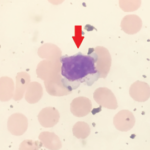It’s possible, Dr. Coblyn said, the rituximab treatment could have obscured or delayed the diagnosis, but it’s unknown whether that was the case.
Cervical Spine & RA
This case involved a 55-year-old woman with longstanding RA and increasing knee pain. On examination, she also had numbness in her hand, which worried an orthopedics colleague, so the patient had spine film X-rays with flexion and extension views.
Neurologic manifestations of RA that don’t involve the CNS include entrapment neuropathies, peripheral neuropathies, rheumatoid nodules and mononeuritis multiplex.
The patient’s X-rays showed a “dramatic” separation between the anterior arch of C1 and the odontoid process, which is evidence of subluxation of the C1 and C2 vertebrae (C1–2).
Clues for C1–2 subluxation include upper or lower extremity numbness, C2–3 radicular pain and brainstem symptoms, such as drop attacks, dysphagia or vertigo. But there may be no symptoms.
“You really need to have a high index of suspicion,” Dr. Coblyn said. “Don’t wait for symptoms.”
A difficult question in these cases is whether to intervene. A C1–2 distance of more than 8 mm is often a sign to intervene. But the posterior atlanto-odontoid interval might be a better indicator of whether to do surgery: A distance of less than 14 mm is often used as a cut-off, Dr. Coblyn said.
Dr. Coblyn mentioned one study that showed dramatically different results for surgery and non-surgery.1 Nineteen patients with cervical lesions caused by RA were treated with surgery at one hospital, and 21 others were treated without surgery at another. The survival rate for the surgery group was 84% at five years and 37% at 10 years. The non-surgery group showed worsening of neurologic symptoms in 76%. All were bed-ridden at three years, and all had died by eight years.
“This, I think, is a pretty powerful suggestion that if you have someone with these conditions with myelopathy and C1–2 subluxation and/or basilar invagination (a folding-in of the skull base when the C2 vertebra migrates upward), you probably want to go ahead and do that surgery,” said Dr. Coblyn.
Felty’s syndrome & LGL in RA
Felty’s syndrome—a combination of RA, enlarged spleen and low white blood cell count—can be a precursor to LGL syndrome in RA. Dr. Coblyn said 85–90% of patients with RA and LGL are seropositive for HLA-DR4. RA in those with Felty’s and LGL tends to present later and have a more benign course than those presenting with de novo LGL.



